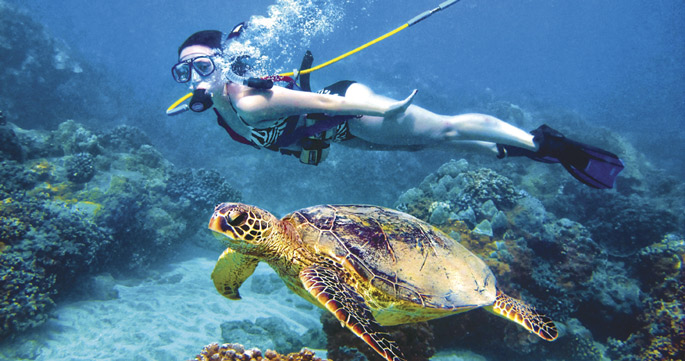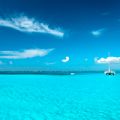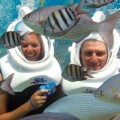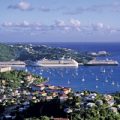Adventurous ways to fly above or float below the waves.
St. Thomas is a water-sports paradise. You can fish for trophy marlin, dive wrecks, snorkel reefs, sail the trade winds, paddle a quiet cove or just relax on the beach. And in addition to these expected aquatic pleasures, you can also tap into some unique technologies that take you under—or over—the water in unusual and exciting ways. Here are three water adventures you have to try the next time you visit the island.
Ironman on the Water
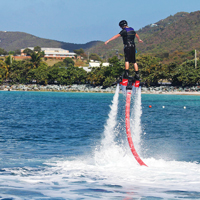
Hovering on a flyboard, Lindberg Bay, St. Thomas. Photo: St. Thomas Flyboarding
It’s the next best thing to Tony Stark’s flight suit. A couple of years ago, pro watercraft racer Franky Zapata routed the water-jet exhaust of his machine through a long hose to a stand-atop platform fitted with hand and foot nozzles. This launched an international craze now known as Flyboard®. Strap into one of these devices and you can soar and hover above the water like Ironman or redirect the water jets for a dive below the surface to race like a dolphin. To experience the rush for yourself, head to the Island Beachcomber Hotel, which is home base for St. Thomas Flyboarding.
Owners Tom Fields and Jeff Andrade were professional kiteboarders before discovering Flyboard®, and becoming early converts. They were certified as instructors for the new sport and started a part-time operation on the island of St. Kitts. In the summer of 2013, they relocated to St. Thomas and the Beachcomber. It’s an ideal location, Fields says, because they are close to town, but have direct access to Lindberg Bay, which has some of the calmest waters on the island’s south shore. Before taking to the air, neophyte fliers are given protective gear, such as helmets and life jackets, and introduced to the basics of flight control during a beachside orientation. Then it’s on to the water to practice hovering and controlling the board at low levels before gaining altitude.
“It’s easy to learn,” Fields says. “Our oldest customer so far was a 67-year-old lady, and she got the hang of it in five minutes. We start things off low and like to keep people in their comfort zone. But if you want to go for it, you can get as high as 30 feet.”
St. Thomas Flyboarding is currently launching just one guest at a time, and can handle about 20 participants a day. Reservations are suggested, and a morning flight gives you a jump on the cruise-ship traffic. Pricing runs $130 for 30 minutes or $200 for a full hour. stthomasflyboarding.com
Diving, No Tanks
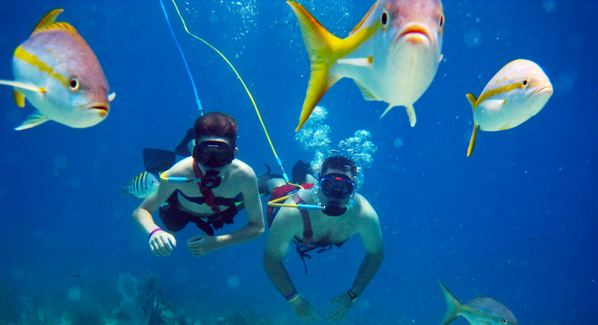
Virgin Islands SNUBA Excursions operated for more than 20 years, putting thousands underwater. Photo: VI SNUBA Excursions
Most everyone who has snorkeled a reef has felt the urge to go a bit deeper. Doing so usually requires you to take a SCUBA diving course, don heavy equipment and learn the rules of decompression and air management. Or, you could sign up for a SNUBA experience. This underwater breathing system leaves the tank on the surface in a small flotation raft and supplies air to the diver by way of a long air hose attached to a compact mouthpiece.
Diving with a SNUBA rig feels more like swimming, as there is no body-hugging buoyancy compensator or tank to create drag. Even more important, the air hose keeps the diver from going too deep and getting into trouble. By staying at depths of 20 feet or less—which is also the part of the reef that has the most color—and by limiting dive times to a half hour, SNUBA users don’t have to monitor risk factors such as nitrogen loading and ascent rates, which are important when SCUBA divers go deeper or stay longer.
To enjoy a SNUBA dive, participants need only to master two of the most basic skills of diving: clearing their ears on the way down by swallowing, and exhaling as they ascend. As a result, no special certification is required, and persons as young as 8 years old can participate. In addition, the dives take place under the watchful eye of a guide who is a certified divemaster or instructor.
Frank and Tammy Cummings are not only the original SNUBA guides in the U.S. Virgin Islands, they are probably the most experienced providers in the world. Frank was the first licensee for the SNUBA program, and since moving from Northern California to open Virgin Islands SNUBA Excursions some 26 years ago, he and Tammy have lead tens of thousands of participants underwater to enjoy the reefs of St. Thomas and St. John.
For a number of years, the Cummings worked with Coral World to host tours in St. Thomas’ Coki Bay. They still provide tours in this location, but Frank says he prefers St. John, where he leads smaller groups on excursions to less-crowded Trunk Bay.
“I don’t like to run the big numbers,” he says. “I’d rather give people a longer and more personal experience, and St. John is perfect for that.” Trunk Bay is not only a scenic venue, it is part of the Virgin Islands National Park and has some of the island’s best coral formations.
A SNUBA Tour with the Cummings runs $74 for adults, four dollars less for kids under 12. Frank says he’s guided a number of divers who were in their 80s, and recalls one who may have been north of 90. The only requirements are basic swimming skills and a sense of adventure. visnuba.com
Head in a Bubble
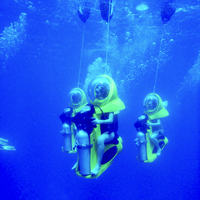
The BOSS keeps the pilot’s head in an air bubble. Photo: Aqua Adventures
They resemble bubble gum dispensers set atop a vintage Vespa motor and go by various acronyms. Whatever the name, these personal submersibles allow a passenger to explore the underwater world while keeping their head out of the water.
In St. Thomas, these little underwater motor scooters are known as the BOSS, as in Breathing Underwater Submersible Scooter. It’s not quite a submarine because the air you breathe becomes slightly pressurized as you descend, and it’s constantly refreshed from a hidden air tank that bubbles gently into the cowling. But at the shallow depths at which these vehicles operate, there’s no need to worry about decompression or pressure changes, and all you need to do is breathe normally and admire the view through the hemispherical face plate. The view is accentuated by the curvature of the bubble, which creates a wide-angle vista much like a camera’s fisheye lens. This panoramic perspective keeps most people from feeling claustrophobic—and you can even wear your spectacles or contacts while inside.
Boss tours are given by Aqua Adventures, which stages day trips to Buck Island National Wildlife Refuge (not to be confused with the Buck Island Reef National Monument in St. Croix). From the harbor in Charlotte Amalie, it’s a 15-minute run in open water to a sheltered cove on Buck Island aboard a 60-foot motorboat that’s been specially configured to transport and launch the BOSS submersibles.
Once in calm water, there’s an orientation briefing, then passengers take their turn in the BOSS and spend the remainder of their trip snorkeling or relaxing on deck. You climb aboard while the scooter is on the surface, which requires just a quick duck-under to get your head into the bubble. Once you are comfortable, the tour guide, who is a certified divemaster or SCUBA instructor, will drop your vehicle down to its cruising depth of eight feet. This may sound shallow, but when looking out, you have the illusion of cruising deeper below the waves, thanks to the bubble optics, while features along the bottom are seen in sharp relief.
Minimum age for the adventure is 10, and the only physical requirement is the ability to climb a short dive ladder when re-boarding the boat, with crew ready to assist if need be.
The three-hour BOSS and snorkel excursion to Buck Island currently runs $129. This tour is popular with the cruise-ship crowd, so if you want to work it into an island stay, you should reserve well in advance. bossusvi.com

